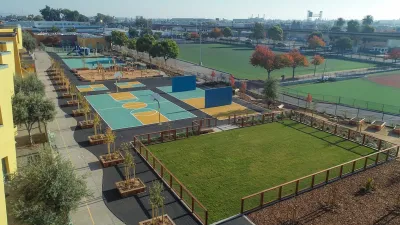In a part of Staten Island largely developed before formal sewer systems were in place, the effort to address both logistics and environmental issues offers lessons for other urban areas.
"By the 1980s, the lack of underground pipes for sanitary and stormwater sewers had led to failing septic systems, degraded water quality, erosion and flooding. The solution to this problem, twenty years (and counting) in the making, is an inspiring case study of coordinating infrastructural imperatives with ecological priorities."
Urban Omnibus talks with Dana Gumb about the project.
"Dana Gumb has been working on the Staten Island Bluebelt since 1988. He started first with the Department of City Planning and then went on to lead the Bluebelt project at the Department of Environmental Protection (NYC DEP), the agency responsible for the City's water supply - that's 1 billion gallons a day, 7,000 miles of water mains and 7,400 miles of sewer lines. NYC DEP started acquiring property for the Bluebelt in the early 1990s and since 1995 has worked with the water engineering firm Hazen and Sawyer alongside teams of consultants ranging from environmental planners to archaeologists to architects."
FULL STORY: The Staten Island Bluebelt: Storm Sewers, Wetlands, Waterways

Study: Maui’s Plan to Convert Vacation Rentals to Long-Term Housing Could Cause Nearly $1 Billion Economic Loss
The plan would reduce visitor accommodation by 25% resulting in 1,900 jobs lost.

Alabama: Trump Terminates Settlements for Black Communities Harmed By Raw Sewage
Trump deemed the landmark civil rights agreement “illegal DEI and environmental justice policy.”

Why Should We Subsidize Public Transportation?
Many public transit agencies face financial stress due to rising costs, declining fare revenue, and declining subsidies. Transit advocates must provide a strong business case for increasing public transit funding.

Paris Bike Boom Leads to Steep Drop in Air Pollution
The French city’s air quality has improved dramatically in the past 20 years, coinciding with a growth in cycling.

Why Housing Costs More to Build in California Than in Texas
Hard costs like labor and materials combined with ‘soft’ costs such as permitting make building in the San Francisco Bay Area almost three times as costly as in Texas cities.

San Diego County Sees a Rise in Urban Coyotes
San Diego County experiences a rise in urban coyotes, as sightings become prevalent throughout its urban neighbourhoods and surrounding areas.
Urban Design for Planners 1: Software Tools
This six-course series explores essential urban design concepts using open source software and equips planners with the tools they need to participate fully in the urban design process.
Planning for Universal Design
Learn the tools for implementing Universal Design in planning regulations.
Smith Gee Studio
Alamo Area Metropolitan Planning Organization
City of Santa Clarita
Institute for Housing and Urban Development Studies (IHS)
City of Grandview
Harvard GSD Executive Education
Toledo-Lucas County Plan Commissions
Salt Lake City
NYU Wagner Graduate School of Public Service





























